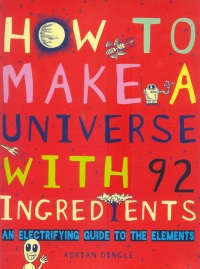| ________________
CM . . .
. Volume XX Number 29. . . .March 28, 2014
excerpt:
How to Make a Universe with 92 Ingredients begins by explaining the elements, the Periodic Table and then what happens when the “elements get together” (p. 12). The next four chapters look at different aspects of daily life and our surroundings – examining the chemistry behind the item or process. The chapter titles help the reader understand the area that is being examined. For example, the chapter on “Materials” is then broken down into “Fun with Fireworks!, Ba-Ba-Boom!, Puttering around with Paints!, Dazzling with Diamonds, Let’s Be Clear about Glass, Dish the Dirt on Soap, Burning Questions about Gasoline, The Power of Attraction, and Skyscrapers” (p. 3). In each section, there is an clear explanation of the chemical process in language that is child-friendly. There are many “try this” sections which are mini experiments that can be done at home and that connect well to the sections. Each section is visually appealing, well-illustrated with terms explained. Further, there is a glossary at the end of the text, “Cool Words”, to assist the reader as well as a “Find Out More” section for children who want to ‘find out more’. How to Make a Universe with 92 Ingredients is a wonderfully descriptive text on the everyday items we see and use but might not have considered the chemistry processes that are involved. It helps bring the chemistry component of each item to our attention. It is a great text for children who are interested in science and who ask “why?” or “how come?” questions. For educators, it would also be an excellent teaching resource for P-10 Science teachers as it connects the science content that we are to teach to everyday life, meeting STSE and STEM outcomes. Highly Recommended. Katarin MacLeod, PhD., is an Assistant Professor in Science Education at St. Francis Xavier University in Antigonish, NS. Her areas of interest include physics educational research (PER), and the incorporation of science, technology, society and environment (STSE) as well as science, technology, engineering, and mathematics (STEM) outcomes into science courses at all levels to help students understand the relevancy of science, increase scientific literacy, and to promote citizenship.
To comment
on this title or this review, send mail to cm@umanitoba.ca.
Copyright © the Manitoba Library Association. Reproduction for personal
use is permitted only if this copyright notice is maintained. Any
other reproduction is prohibited without permission.
NEXT REVIEW |
TABLE OF CONTENTS FOR THIS ISSUE
- March 28, 2014.
AUTHORS |
TITLES |
MEDIA REVIEWS |
PROFILES |
BACK ISSUES |
SEARCH |
CMARCHIVE |
HOME |
